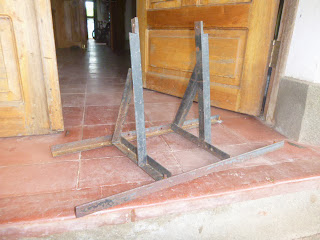Deliverable: Final Report
Our bike stand project is done and done; the final report is submitted, we showed off our design at an engineering open house, and I believe the only thing left to do is complete a survey about the class.
Our final design did not work, which is a bummer. We splayed the two frames out to the side and incorporated support triangles onto each of the four corners. Although we could screw in the top of the hypotenuse to the design, we had to epoxy the bottom corners, so we should have realized this plan wouldn't work.
When we tried out the design, our bike stand fell apart at the seams (no thanks to you, epoxy!).
Problems abound. First, it takes two people to mount the
bike on the stand. One person has to lift the bike, while the other has to
position each side of the bike stand and simultaneously make sure that no gears
or brake wires are caught in the bike stand. Second, during our process of
prototype refinement, we didn’t foresee the extent to which stress
concentration points would affect the usability of the bike stand, which
resulted in the bike stand tipping to the side almost immediately after the
rider got on. Third, the chainstay support doesn’t completely support both sides of the chainstays.
The weight is distributed unequally which causes the bike to tip back and
forth. Fourth, the screws that come up from the bottom create an uneven
surface- the screw heads create a slight but significant decrease in stability.
In short, it was unrealistic to expect screws to be a practical mechanism to
adjust for different bike sizes, and perhaps more importantly, to remain tight
against the pressure of riding the bike on the stand.
If you'd like to read our final report, here's the link. Even though we didn't produce a working bike stand for our partners in Nicaragua, we made good progress on designing a better bike stand. I hope that engineers in the future will be able to use our report to help eliminate some options that don't work, or see what we have and improve.
If you have any questions we'd be more than happy to answer them in the comments. Other than that, thanks for reading!











































.JPG)
.JPG)


.JPG)



